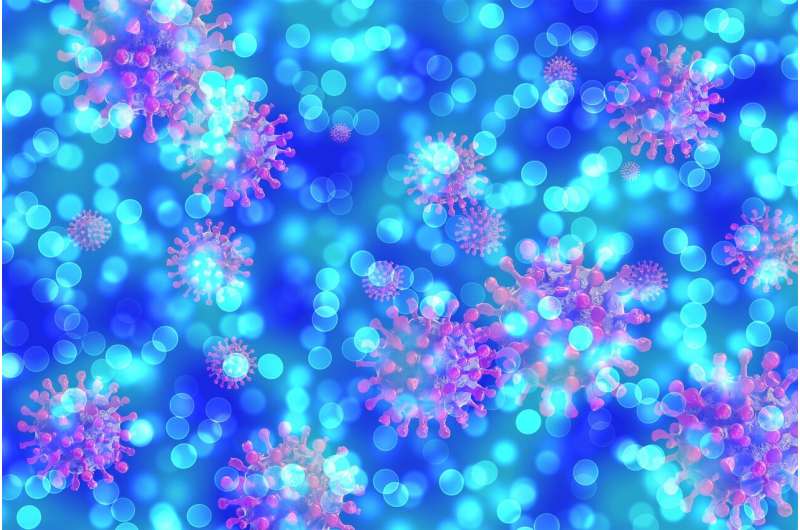This article has been reviewed according to Science X's editorial process and policies. Editors have highlighted the following attributes while ensuring the content's credibility:
fact-checked
trusted source
written by researcher(s)
proofread
Facts about LB.1, or D-FLiRT, the newest COVID subvariant

Headlines are again warning of a new COVID variant in Australia. This time it's LB.1, or as some experts have dubbed it, "D-FLiRT."
Emerging evidence suggests LB.1 could be more transmissible than earlier omicron subvariants, though there's nothing to suggest it will cause more severe disease.
But before we look more closely at LB.1, how did we get here in the first place? The COVID virus is a crafty thing, continuing to evolve so it can keep infecting us.
From XBB to JN.1 to FLiRT to FLuQE
Our current COVID vaccines are based on XBB.1.5, a subvariant of omicron. Along with other XBB subvariants, XBB.1.5 caused a wave of COVID cases around the world in 2023.
In August 2023, a new subvariant called JN.1 was discovered in Luxembourg. Until that point, new omicron subvariants only had small genetic changes from their predecessors (called genetic drift).
However, JN.1 was unusual in that it was 41 mutations away from XBB.1.5 (big changes like this are called genetic shifts). Because of these changes, it was expected that JN.1 would take off, and indeed, JN.1 caused another wave of infections in Australia and around the world at the end of 2023 and the beginning of this year.
JN.1 then mutated further, giving us the "FLiRT" subvariants such as KP.1.1, JN.1.7 and KP.2.
Proteins including the spike protein (a protein on the surface of the virus which allows it to attach to our cells) are made up of amino acids, essentially molecular building blocks. When scientists "sequence" new variants, they work out the exact order of amino acids in the spike protein, as this can change the behavior of the virus.
Each amino acid has its own letter abbreviation. The FLiRT variants were named for two genetic mutations to the spike protein. The sequence changed from phenylalanine (F) to leucine (L) at position 456 (genetic mutation F456L), and from arginine (R) to threonine (T) at position 346 (R346T).
Research yet to be peer-reviewed suggests these genetic changes gave the FLiRT subvariants better capacity to evade our immune responses, but slightly poorer ability to establish an infection once they get into our cells (sometimes called binding efficiency).
The FLiRT subvariants have themselves now mutated. Some of these new subvariants are called FLuQE, and include KP.3, which along with KP.2 is currently dominating around the world.
These are similar to the FLiRT subvariants with additional genetic mutations. One is called Q493E—hence the name FLuQE. Along with another mutation, F456L, these changes appear to have helped the virus regain some of its reduced ability to infect cells compared to FLiRT by increasing binding efficiency.
From FLiRT to LB.1
Reports suggest LB.1 was first detected in March 2024. LB.1 is similar to the FLiRT subvariants but with an additional mutation in the spike protein called S:S31del. The "del" refers to a deletion—a genetic change where a part of the virus' genetic sequence is removed or lost during replication. In this case, the 31st amino acid (serine) in the spike protein is removed.
For this reason, it's been given the nickname "D-FLiRT" or "DeFLiRT." This also covers other variants carrying the same mutations as FLiRT but with this deletion, such as KP.2.3.
Preliminary results from a research group at the University of Tokyo, who conducted modeling and lab experiments with these emerging subvariants, indicate the transmissibility of LB.1 and KP.2.3 may be higher than both KP.2 and KP.3.
Should we be worried about LB.1?
LB.1 has been detected in multiple countries, including Australia, and is being monitored closely by bodies like the World Health Organization and the CDC.
In the United States, as of July 15, KP.3 accounted for about 37% of cases, KP.2 for 24% and LB.1 for another 15%, having been steadily rising over recent weeks.
KP.3 and its descendants such as KP.3.2 and KP.3.2.1 (FLuQE subvariants) are similarly dominating in Australia, accounting for at least 50% of cases. We don't know what proportion of cases LB.1 is making up in Australia at present. It's possible LB.1 infections are still negligible, but they may well grow over time.
While COVID cases appear to be declining after a recent wave in Australia, LB.1 may eventually out-compete KP.3, and between them, cause another wave of cases.
We are already seeing a bad season for respiratory viruses with both RSV and influenza cases higher than last year. So a variant with increased transmissibility could add to our winter woes.
The good news is there's no evidence to suggest LB.1 causes any different symptoms or more severe illness than previous omicron subvariants.
The current vaccines based on XBB.1.5 should still give some cross immunity against LB.1, and oral antivirals such as Paxlovid and Lagevrio should still work. We will likely be getting an updated vaccinebased on KP.2, probably towards the end of the year. That should provide better protection against these new subvariants since genetically, they're very similar to KP.2.
This article is republished from The Conversation under a Creative Commons license. Read the original article.![]()





















